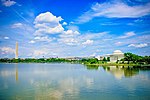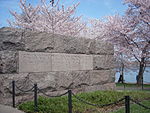George Mason Memorial
2002 establishments in Washington, D.C.2002 sculpturesAC with 0 elementsArtworks in the collection of the National Park ServiceBooks in art ... and 13 more
Bronze sculptures in Washington, D.C.Buildings and structures completed in 2002George MasonMonuments and memorials on the National Register of Historic Places in Washington, D.C.National Mall and Memorial ParksNational Park Service areas in Washington, D.C.Outdoor sculptures in Washington, D.C.Protected areas established in 2002Sculptures of men in Washington, D.C.Southwest (Washington, D.C.)Statues in Washington, D.C.Statues of U.S. Founding FathersUse mdy dates from April 2020

The George Mason Memorial is a memorial to Founding Father George Mason, the author of the Virginia Declaration of Rights that inspired the United States Bill of Rights. The Memorial is located in West Potomac Park within Washington, D.C. at 24 E Basin Drive SW, which is a part of the Tidal Basin. Authorized in 1990, with a groundbreaking in 2000 and dedication in 2002, the memorial includes a sculpture of Mason, a pool, trellis, circular hedges, and numerous inscriptions. It was the first memorial in the Tidal Basin area to be dedicated to someone who was not a former President of the United States.
Excerpt from the Wikipedia article George Mason Memorial (License: CC BY-SA 3.0, Authors, Images).George Mason Memorial
14th Street Bridge Sidepath, Washington
Geographical coordinates (GPS) Address Nearby Places Show on map
Geographical coordinates (GPS)
| Latitude | Longitude |
|---|---|
| N 38.879444444444 ° | E -77.039166666667 ° |
Address
Fountain Four
14th Street Bridge Sidepath
20228 Washington
District of Columbia, United States
Open on Google Maps










